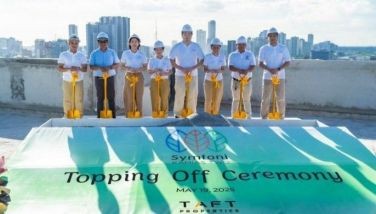Reclaiming the streets, sidewalks

Deployed as traffic enforcers along EDSA, the police Highway Patrol Group or HPG did two notable things: buses and jeepneys were not allowed to linger too long at stops, and the avenue was cleared of vendors.
On Day One of the deployment, motorists and commuters were pleasantly surprised by the dramatic result: traffic flowed quicker if not completely smoothly at the six chokepoints where the HPG was deployed. (Day Two, Carpocalypse Tuesday, was another story.)
In fact the same result is seen each time the service road in front of the Redemptorist Church in Baclaran, Parañaque is cleared of vendors and buses are not allowed to pick up passengers along Roxas Boulevard. Instead the buses are confined to the service road and an area where they wait in line for passengers before driving away, mainly toward EDSA.
The Baclaran vendors are also confined within an area just outside the church, where they cannot block vehicular traffic. This shows that micro enterprises can continue without disrupting traffic flow.
It helped that the HPG members were not taking orders from several mayors but from a central command with jurisdiction over the entire metropolis.
Along the southbound lane of Roxas Boulevard in Baclaran last Friday, traffic uncharacteristically flowed smoothly as buses and jeepneys were not allowed to turn the area around the foot of the EDSA flyover into their terminal. Instead of barkers openly collecting fees from bus and jeepney drivers, presumably for the privilege to occupy nearly all the road lanes and linger for a long time to wait for passengers, the place crawled with traffic enforcers.
You’d think all it takes is common sense to do this all over crowded Metro Manila. But there are so many other considerations that get in the way of keeping vehicular traffic moving around the National Capital Region.
What can the HPG do, for example, when the city government closes off the south end of Taft Avenue connected to Redemptorist Road in Baclaran, Paranaque and allows vendors to occupy the busy street? That Taft-EDSA junction is one of the six chokepoints where the HPG is assigned.
The same has been done along the stretch of C.M. Recto Avenue past J. Abad Santos in Divisoria, Manila. Instead of trying to find ways of adding to the road network, limited as it is, local government officials are turning over busy arteries completely to hawkers.
I was born and bred in Manila with C.M. Recto functioning as a regular avenue, with sidewalk vendors keeping to the sidewalks. Why have the hawkers been allowed to take over such a busy section of a busy thoroughfare?
For sure the city governments collect fees from the hawkers, and it’s good to allow micro, small and medium enterprises to thrive. And for sure, an important factor for mayors and other local government executives including barangay officials is that they earn brownie points with the vendors. Mall rentals are prohibitive for the average Pinoy entrepreneur.
But city officials must balance the needs of a few hundred hawkers with the plight of hundreds of thousands – possibly millions – of motorists and commuters whose mobility and access to public roads are curtailed.
* * *
Last Saturday I went to Manila’s Binondo-Divisoria area and was slowed down by several temporary structures jutting out onto the narrow streets. Two were wakes, with the coffins right on the sidewalk; another was a small religious shrine. All three had tarpaulin roofs with the names of barangay chairmen prominently emblazoned in front. The streets were narrow enough with shanties leaving no room for pedestrians on the sidewalk.
Barangay officials are mandated by law to prevent squatting. They are also tasked to clear road obstructions. Yet all over the country, barangay officials are often the ones who allow wakes to be held right on the street. In some cases, corpses are hired from morgues to hold prolonged wakes that are actually fronts for sakla and other illegal numbers games.
Billions in tax money are spent for the upkeep of barangay offices. Yet there are barangay officials who don’t even know their duties as defined by law, including preventing squatting and assisting victims of domestic violence. It wouldn’t be too bad if barangay councils are simply as useless as the Sangguniang Kabataan or youth councils. But barangay officials are also among the biggest creators of red tape, and several have been found to be protectors of jueteng and even drug trafficking.
Informal settlers are also coddled not just for their votes, but because it’s not unusual for barangay officials to be the landlords themselves of squatters. Real estate is precious even in the slums of Manila, which mushroom around areas with job opportunities such as the ports and Divisoria. A small room in a jerry-built, condominium-type dwelling of flimsy plywood walls and galvanized iron roofing that can accommodate a single bed, a tiny kitchen and dining area, with a communal toilet in an alley, can cost over P2,000 a month. It’s lucrative to be a landlord in the slums.
Because sidewalks have been taken over by vendors and shanties, commuters wait for rides on the street, and jump into buses and jeepneys even in the middle of busy thoroughfares. Vehicular traffic inevitably slows down.
Any traffic scheme will have to include reclaiming the sidewalks for pedestrian use. Again, this sounds like a no-brainer, until you factor in the politicians – from the mayors down to barangay officials – who make it impossible to happen.
Also, more than a straight path or tuwid na daan, you need a smoothly paved road to keep traffic moving. Traffic will never flow smoothly on a baku-bakong daan. Another no-brainer, and yet the craters along Macapagal Boulevard may have to wait until Christmas to be repaired.
People have groused that the HPG deployment has not worked for several of the EDSA chokepoints. HPG officials have also announced that they have limited personnel and they can do traffic management duty only up to 11 p.m. But with so many call centers around, Metro Manila no longer sleeps, and traffic can be heavy even up to midnight and beyond in certain areas.
Still, the HPG is showing that while the inadequate infrastructure and continuing population growth in Metro Manila guarantee that traffic problems will persist, there are ways of easing the daily ordeal of millions. Simply clearing sidewalks for pedestrian use and prohibiting jeepneys and buses from lingering too long on busy roads can work wonders.
These measures don’t call for a miracle. All they need is simple enforcement of the cardinal rule in traffic management, which is to keep vehicles moving.
- Latest
- Trending




























